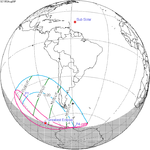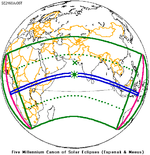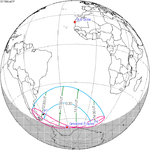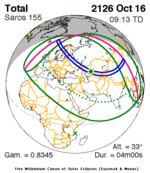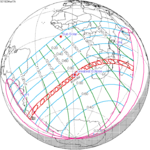| Total eclipse | |
| Gamma | 0.4697 |
|---|---|
| Magnitude | 1.0366 |
| Maximum eclipse | |
| Duration | 189 s (3 min 9 s) |
| Coordinates | 15°36′N32°42′E / 15.6°N 32.7°E |
| Max. width of band | 138 km (86 mi) |
| Times (UTC) | |
| Greatest eclipse | 9:11:35 |
| References | |
| Saros | 139 (26 of 71) |
| Catalog # (SE5000) | 9402 |
A total solar eclipse occurred at the Moon's ascending node of orbit on Monday, February 25, 1952, [1] [2] [3] [4] [5] [6] with a magnitude of 1.0366. A solar eclipse occurs when the Moon passes between Earth and the Sun, thereby totally or partly obscuring the image of the Sun for a viewer on Earth. A total solar eclipse occurs when the Moon's apparent diameter is larger than the Sun's, blocking all direct sunlight, turning day into darkness. Totality occurs in a narrow path across Earth's surface, with the partial solar eclipse visible over a surrounding region thousands of kilometres wide. Occurring 1.4 days after perigee (on February 23, 1952, at 22:30 UTC), the Moon's apparent diameter was larger. [7]
Contents
- Observations
- Eclipse details
- Eclipse season
- Related eclipses
- Eclipses in 1952
- Metonic
- Tzolkinex
- Half-Saros
- Tritos
- Solar Saros 139
- Inex
- Triad
- Solar eclipses of 1950–1953
- Saros 139
- Metonic series
- Tritos series
- Inex series
- Notes
- References
The path of totality crossed French Equatorial Africa, Belgian Congo, Anglo-Egyptian Sudan, Arabia, Pahlavi Iran and the Soviet Union. A partial eclipse was visible for parts of Africa, Europe, West Asia, Central Asia, and South Asia.









